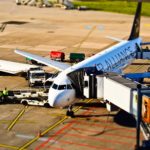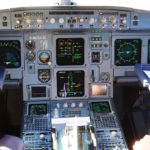Aircraft cleaning standards are regulatory requirements that civil aviation authorities (worldwide) impose on the airline operators to ensure the minimum level of cleanliness onboard. The purpose of cleaning standards in commercial aircraft is to ensure the health and safety of passengers and crew.
International Health Regulations
Annexe 1 B 1 (d) of the IHR (2005) requires every airport specifically designated by a State to have or develop within a limited period the capacity to provide safe potable water supplies
for travellers using airport facilities. In accordance with Article 24 (c) of the IHR (2005), all States are required to take all practicable measures to ensure that international conveyance operators keep their conveyances free of sources of contamination and infection, which should include drinking water. However, it is the responsibility of each aircraft operator to ensure that no sources of infection and contamination are found on board.
World Health Organization (WHO) on Aircraft Cleaning Standards
Health and sanitation aspects of international traffic have been of concern to the World Health Organization (WHO) since 1951, when the Fourth World Health Assembly recommended that all governments should “improve sanitary and environmental conditions, especially in and around ports and airports” (resolution WHA4.80); at the same time, the need for “the sanitary protection of populations in mass movement” was also expressed (resolution WHA4.8l). Subsequent resolutions of both the World Health Assembly and the Executive Board emphasized the importance of maintaining high standards of hygiene and sanitation in international traffic (particularly in relation to the provision of safe water and food and the correct procedures for the collection and disposal of wastes). The annexe to the first report of the WHO Expert Committee on Hygiene and Sanitation in Aviation (WHO, 1960a) was published in 1960 as a Guide to Hygiene and Sanitation in Aviation (WHO, 1960b). Its use was recommended by the Twelfth World Health Assembly to guide health administrations in “fulfilling their obligations under the existing International Sanitary Regulations, especially the provisions of Article 14, in providing safe food for international air traffic, and in maintaining satisfactory control of, and protection from, malaria vectors at airports” (resolution WHA12.18).
The annexe to the first report of the WHO Expert Committee on Hygiene and Sanitation in Aviation (WHO, 1960a) was published in 1960 as a Guide to Hygiene and Sanitation in Aviation (WHO, 1960b). Its use was recommended by the Twelfth World Health Assembly to guide health administrations in “fulfilling their obligations under the existing International Sanitary Regulations, especially the provisions of Article 14, in providing safe food for international air traffic, and in maintaining satisfactory control of, and protection from, malaria vectors at airports” (resolution WHA12.18).
The reports of the Committee on International Surveillance of Communicable Diseases, as adopted by the World Health Assembly, also emphasized the importance of preventing disease through the improvement of sanitary conditions. The relevant articles of the International Health Regulations (1969) (WHO, 1969) laid down sanitation requirements at airports. The provision of criteria and guidelines for the use of administrations in fulfilling their obligations under the International Health Regulations forms an essential part of WHO’s functions.
In 1974, the Twenty-seventh World Health Assembly, “believing that, in view of the growth of international traffic, continuous attention should be given to the safety of food and water and the handling of wastes in such traffic”, stressed “the need for each Member State to clarify the ultimate responsibility for the safety of food and water and the proper handling of wastes in international traffic” and, furthermore, recommended that “Member States coordinate and ensure the close and active participation in such a responsibility of health authorities, port and airport management, aircraft operators, shipping companies, tourist associations, and any other service or agency concerned with international traffic” (resolution WHA27.46). At the same time, the Director-General of WHO was requested to maintain close contact with representatives of international organizations concerned with international traffic with a view to promoting the implementation and coordination of activities aimed at improving the safety of food and water and the handling of wastes and to prepare appropriate guidance for the use of health professionals. The outcome of these activities was the publication of a second edition of the Guide to Hygiene and Sanitation in Aviation, in 1977 (WHO, 1977).
The basic principles of hygiene have not changed significantly since 1977; however, the magnitude of air transport operations has grown tremendously. The number of passengers flying on scheduled airlines rose from 438 million in 1975 to over 2 billion in 2006 (ICAO, 2006), figures that do not take into account charter flight passengers and global corporation business jet passengers, whose numbers are in the millions and increasing every year. Furthermore, the current trend in international civil aviation is towards aircraft of larger passenger-carrying capacity and greater range. The introduction of air services to areas with inadequate public health infrastructures, such as food handling and storage, water supply and waste disposal, creates a challenge for aircraft operators. To protect public health, the application of high standards of hygiene should form an integral part of airport and aircraft operations.
International Civil Aviation Organization (ICAO)
The third edition of the Guide to Hygiene and Sanitation in Aviation (hereafter referred to as “the Guide”) addresses water, food, waste disposal, cleaning and disinfection of facilities, vector control and cargo safety, with the ultimate goal of assisting all types of airport and aircraft operators and all other responsible bodies in achieving high standards of hygiene and sanitation, to protect travellers and crews engaged in air transport. Each topic is addressed individually, with guidelines that provide procedures and quality specifications that are to be achieved.
Airlines are responsible for the food they serve on board aircraft, whether it is prepared in an airline-owned “flight kitchen” or obtained from an independently owned catering company. The steps involved—including food preparation, transport to the aircraft, storage and, finally, serving on the aircraft—need to be well coordinated in order to avoid contamination.
Routine cleaning and disinfection are also important aspects of aircraft and airport operations. In addition, aircraft disinfection procedures following transport of a suspected case of communicable disease are a particularly difficult issue that needs to be addressed by many stakeholders in a cooperative approach; not all effective disinfectants are suitable for use on board aircraft, as they may cause corrosion or other damage to the aircraft structure and contents, or their fumes may be noxious to inhale in an unventilated space. WHO, IATA, aircraft manufacturers and ICAO are the main organizations involved in determining a suitable disinfection process at the international level.
International Organizations for Aircraft Cleaning Standards
In addition to the responsibilities of the individual stakeholders (aircraft and airport operators, ground service providers, etc.), several international bodies, such as the International Civil Aviation Organization (ICAO), the International Air Transport Association (IATA) and the Airports Council International (ACI), play an important role in protecting the health of passengers and crew.
Aeronautical Radio, Inc. – Industry Activities (ARINC)
African Airlines Association (AFRAA)
African Civil Aviation Commission (AFCAC)
Agence pour la Sécurité de la Navigation Aérienne en Afrique et à Madagascar (ASECNA)
Airport Consultants Council (ACC)
Airports Council International (ACI)
Air Transport Association (ATA) of America, Inc.
Arab Air Carriers Organization (AACO)
Arab Civil Aviation Commission (ACAC)
Association of Asia Pacific Airlines (AAPA)
Association of European Airlines (AEA)
Civil Air Navigation Services Organisation (CANSO)
Comisión Latinoamericana de Aviación Civil (CLAC)
Corporación Centroamericana de Servicios de Navegación Aérea (COCESNA)
European Association For Aviation Psychology (EAAP)
European Aviation Safety Agency (EASA)
European Civil Aviation Conference (ECAC)
European Federation of Airline Dispatchers Associations (EUFALDA)
European Organisation for the Safety of Air Navigation (EUROCONTROL)
European Regions Airline Association (ERA)
European Union at the United Nations
Fédération Aéronautique Internationale (FAI)
Flight Safety Foundation (FSF)
Helicopter Association International (HAI)
International Air Carrier Association (IACA)
International Air Transport Association (IATA)
International Association of Airport & Seaport Police (I.A.A.S.P.)
International Association of Airport Executives (IAAE)
International Business Aviation Council (IBAC)
International Committee for Airspace Standards and Calibration (ICASC)
International Council of Aircraft Owner and Pilot Associations (IAOPA)
International Federation of Air Line Dispatchers’ Associations (IFALDA)
International Federation of Air Line Pilots’ Associations (IFALPA)
International Federation of Air Traffic Controllers’ Associations (IFATCA)
International Federation of Air Traffic Safety Electronics Associations (IFATSEA)
International Federation of Airworthiness (IFA)
International Federation of Freight Forwarders Associations (FIATA)
International Register of Civil Aircraft (IRCA)
International Society of Air Safety Investigators (ISASI)
International Transport Workers’ Federation (ITF)
International Transportation Safety Association (ITSA)
Interstate Aviation Committee (IAC)
Joint Aviation Authorities (JAA)
Pacific Aviation Safety Office (PASO)
Service de l’information aéronautique (SIA)
United Nations – Official Web Site Locator for the United Nations System of Organizations
World Airlines Clubs Association (WACA)
National Level Cleaning Standards
Aircraft operators are involved at many levels in the chain of events that provide a hygienic and sanitary environment for air travellers and crew. For example, aircraft operators obtain potable water from numerous sources, and they have to ensure that each source provides drinking-water of acceptable quality. Water transfer is a key aspect of loading water onto the aircraft from the mains supply. The aircraft operator has the responsibility, in concert with the airport and relevant health authority, to ensure that proper transfer procedures are observed.
The safety of the potable water supply at the airport (including for provision to aircraft) is generally under the operational responsibility of the airport operator. The airport operator is generally subject to surveillance by the governmental authority responsible for regulating or licensing environmental health standards for facilities open for public use.
Afghanistan
Ministry of Transport and Civil Aviation
Albania
Albanian Civil Aviation Authority (ACAA)
Algeria
Établissement de Gestion de Services Aéroportuaires d’Alger (EGSA)
Établissement Nationale de la Navigation Aérienne (ENNA)
Angola
Instituto Nacional da Aviação Civil
Argentina
Administración Nacional de Aviación Civil
Servicio Meteorológico Nacional
Armenia
General Department of Civil Aviation
Australia
Australian Transport Safety Bureau (ATSB)
Civil Aviation Safety Authority
Department of Infrastructure, Transport, Regional Development and Local Government
International Air Services Commission
Austria
Ministry of Transport, Innovation and Technology
Azerbaijan
Bahrain
Bahamas
Bangladesh
Bangladesh Meteorological Department
Ministry of Civil Aviation and Tourism
Belarus
Belgium
Service public fédéral Mobilité et Transports
Bermuda
The Bermuda Civil Aviation Authority (BCAA)
Bolivia
Dirección General de Aeronáutica Civil
Bosnia and Herzegovina
Brazil
Agência Nacional de Aviação Civil (ANAC)
Brazilian Civil Aviation Certification Division
Centro de Investigação e Prevenção de Acidentes Aeronáuticos (CENIPA)
Brunei Darussalam
Bulgaria
Cambodia
Ministry of Public Works and Transport
State Secretariat of Civil Aviation (SSCA)
Cameroon
Civil Aviation Authority (CAA)
Canada
Canadian Transportation Agency
Department of Foreign Affairs and International Trade
National Search and Rescue Secretariat
Transportation Development Centre (TDC)
Transportation Safety Board of Canada
Cabo Verde
Agência de Aviação Civil (AAC)
Chile
Dirección General de Aeronáutica Civil
China
Air Traffic Management Bureau (ATMB), General Administration of Civil Aviation of China
Beijing – Civil Aviation Administration of China
Hong Kong – Civil Aviation Department
Colombia
República de Colombia Aeronáutica Civil
Comoros
Costa Rica
Dirección General de Aviación Civil
Côte d’Ivoire
Autorité Nationale de l’Aviation Civile
Croatia
Croatian Civil Aviation Agency
Cyprus
Department of Civil Aviation of Cyprus
Czech Republic
Air Accidents Investigation Institute
Denmark
Danish Transport and Construction Agency
Dominican Republic
Instituto Dominicano de Aviación Civil
Ecuador
Dirección General de Aviación Civil del Ecuador
Egypt
El Salvador
Autoridad de Aviación Civil – El Salvador
Estonia
Estonian Civil Aviation Administration
Fiji
Finland
France
Bureau d’Enquêtes et d’Analyses pour la sécurité de l’aviation civile (BEA)
Direction générale de l’Aviation civile
Gabon
Agence Nationale de l’Aviation Civile du Gabon
Gambia
Gambia Civil Aviation Authority
Georgia
Georgian Civil Aviation Authority
Germany
Airport Coordination Federal Republic of Germany
Federal Bureau of Aircraft Accidents Investigation
Ghana
Ghana Civil Aviation Authority
Greece
Hellenic Civil Aviation Authority
Hellenic National Meteorological Service
Honduras
Dirección General de Aeronáutica Civil
Hungry
Iceland
Aircraft Accident Investigation Board
India
Bureau of Civil Aviation Security (BCAS)
Directorate General of Civil Aviation
Indonesia
Directorate General of Civil Aviation
Iran (Islamic Republic of)
Iraq
Ireland
Minister for Transport, Tourism and Sport
Israel
Ministry of Transport and Road Safety
Italy
Agenzia Nazionale della Sicurezza del Volo
Ente Nazionale per l’Aviazione Civile (ENAC)
Jamaica
Japan
Civil Aviation Bureau. Ministry of Land, Infrastructure, Transport and Tourism
Jordan
Kenya
Kenya Civil Aviation Authority
Kuwait
Directorate General of Civil Aviation
Kyrgyzstan
Latvia
Lebanon
Directorate General of Civil Aviation
Libya
Libyan Civil Aviation Authority
Lithuania
Luxembourg
Direction de l’aviation civile
Madagascar
Malaysia
Maldives
Mali
Agence Nationale de l’Aviation Civile (ANAC) du Mali
Malta
Mauritius
Mexico
Secretaría de Comunicaciones y Transportes
Mongolia
Montenegro
Morocco
Direction Générale de l’Aviation Civile
Mozambique
Namibia
Directorate of Civil Aviation (DCA Namibia)
Nepal
Civil Aviation Authority of Nepal
Netherlands
Civil Aviation Security Department
Ministry of Transport, Public Works and Water Management
New Zealand
Airways Corporation of New Zealand
Wellington Volcanic Ash Adivsory Centre (VAAC)
Nicaragua
Instituto Nicaragüense de Aeronáutica Civíl
Nigeria
Nigerian Civil Aviation Authority (NCAA)
Nigerian College of Aviation Technology (NCAT), Zaria
Norway
Oman
Public Authority for Civil Aviation
Pakistan
Panama
Autoridad Aeronáutica Civil – Panama
Papua New Guinea
Civil Aviation Safety Authority of Papua New Guinea (CASA)
PNG Accident Investigation Commission
Paraguay
Dirección Nacional de Aeronáutica Civil (DINAC)
Peru
Dirección General de Aeronáutica Civil
Philippines
Poland
Polish Air Navigation Services Agency
Portugal
Instituto Nacional de Aviação Civil
Qatar
Republic of Korea
Ministry of Land, Infrastructure and Transport
Republic of Moldova
Romania
Romanian Civil Aeronautical Authority
Russian Federation
San Marino
Autoritâ per l’Aviazione Civile e la Navigazione Marittima (CAA-MNA-SMR)
Saudi Arabia
General Authority of Civil Aviation (GACA)
Serbia
Center for investigation of accidents in transport of the Republic of Serbia
Seychelles
Seychelles Civil Aviation Authority (SCAA)
Singapore
Air Accident Investigation Bureau of Singapore
Civil Aviation Authority of Singapore
Slovakia
Slovenia
South Africa
Air Traffic and Navigation Services
Spain
Aeropuertos Españoles y Navegación Aérea
Agencia Estatal de Meteorología
Agencia Estatal de Seguridad Aérea
Comisión de Investigación de Accidentes e Incidentes
Dirección General de Aviación Civil
Sri Lanka
Sudan
Suriname
Civil Aviation Department of Suriname
Swaziland
Swaziland Civil Aviation Authority
Sweden
Switzerland
Federal Office for Civil Aviation (FOCA)
Syrian Arab Republic
Syrian Civil Aviation Authority
Thailand
Aeronautical Radio of Thailand Ltd. (AEROTHAI)
The former Yugoslav Republic of Macedonia
Togo
Agence Nationale de l’Aviation Civile (ANAC) du Togo
Tonga
Trinidad and Tobago
Tunisia
Office de l’aviation civile et des aéroports
Turkey
Directorate General of Civil Aviation
Uganda
Ukraine
United Arab Emirates
General Civil Aviation Authority (GCAA)
United Kingdom
Air Accidents Investigation Branch
Air Safety Support International
United Republic of Tanzania
Tanzania Civil Aviation Authority (TCAA)
United States
Aviation Safety Reporting System (NASA ASRS)
Federal Aviation Administration
National Transportation Safety Board
Satellite Navigation Product Teams, Federal Aviation Administration
Transportation Security Administration
U.S. Department of State, Office of Transportation policy
Uruguay
Dirección Nacional de Aviación Civil e Infraestructura Aeronáutica (DINACIA)
Venezuela
Instituto Nacional de Aviación Civil (INAC)
Viet Nam
Civil Aviation Authority of Viet Nam
Yemen
Civil Aviation and Meteorological Authority (CAMA)
Zambia
Zimbabwe
Civil Aviation Authority






